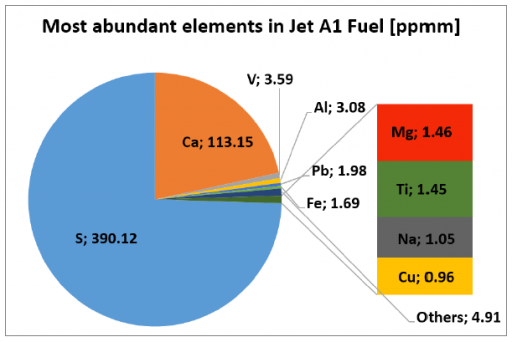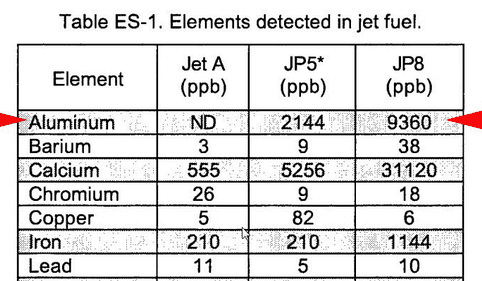A recent tweet By Jim Lee prompted me to look into an old story:
Source: https://twitter.com/rezn8d/status/807229209659711488
There are a couple of problems with this theory:
https://web.archive.org/web/2009022...s.cc/2009/02/16/the-not-so-secret-ingredient/
https://www.fmv.se/FTP/M7789-000193/datablad/M0729-465015_Stadis_450PDS.pdf

What seems to be the source of the error is that the writer on chemtrails.cc confused "dinonylnaphthalene sulfonic acid" (which is a listed ingredient in Stadis) with "dinonylnaphthalene sulfonic acid, barium salt" (which is not), because they were both listed in the EPA document. But they are very different chemicals. One contains barium, and the other (the one in Stadis) does not.
The "EPA study" that would continue to be cited as proof that barium was in Stadis does not even mention Stadis 450!. It is not a study of what is in anything, it's just a study of four forms of dinonylnaphthalene, including the one that's in Stadius, but has no barium in it.
Like many things in the chemtrail mythology these errors were pointed out immediately, but then ignored and the story was repeated.
In April 2009 it showed up on one of the older chemtrail sites Agriculture Defense Coalition.
In Nov 2009, in the Alex Jones "Prison Planet" forum
Source: https://www.youtube.com/watch?v=yiMXbjKaVoY
In 2013 Jim Lee posted here on Metabunk, claiming that barium was in Stadis, unfortunately it was not sufficiently point out to him that it wasn't, so he seems to continue to think that it was, posting on his site in 2015.
https://en.wikipedia.org/wiki/Dinonylnaphthylsulfonic_acid
Source: https://twitter.com/rezn8d/status/807229209659711488
To understand what this means you need a little context. It's referring to the "chemtrails" conspiracy theory, which basically says the government is spraying stuff out of aircraft for some purpose. Frequently proponents of the theory name three common metallic elements (Aluminum, Barium, and Strontium) as being sprayed for either weather control, or climate modification. They test for these metals in soil and water, and find them because they are common in the environment. Jim Lee has his own version of the theory which is that the government is adding stuff to jet fuel. He's suggesting here that Stadis 450 (an anti-static jet fuel additive) has barium in it, and hence barium in Jet Fuel.Stadis450 is an anti-static agent added to jet fuel, is barium, added in 1962, mandatory in all flights.
-rezn8d
There are a couple of problems with this theory:
- There's no barium in Stadis 450, the elemental ingredients are: carbon, hydrogen, oxygen, nitrogen, and sulfur.
- It's added to the fuel at under 5 parts per billion, too small to do anything when diluted in the atmosphere.
Then on "Educate Yourself" in 2005
posted 01-05-2002 08:36 PM Transition Underway for Modified Stadis 450 in Aviation Fuels
But the modern version of the Stadis 450 myth dates back to February 2009 to the defunct site chemtrails.cc, which said:No need for EDB, mark. They have lots of poisonous goodies in there. Try this: http://www.desc.dla.mil/DocumentRepository/t83133e.pdf
...
•Stadis 450 (static dissipator)
https://web.archive.org/web/2009022...s.cc/2009/02/16/the-not-so-secret-ingredient/
This is demonstrably false. Firstly static dissipators like Stadis have no metal content, and neither of the two links given mention metals. In fact the Stadis data sheet (from 2011) quite specifically says it contains no metals.Static dissipators are of particular importance to atmospheric aerosol and environmental research, due to their metal content and their widespread use in commercial and military jet fuel [17, 8]. Octel Starreon Stadis® 450 is a static dissipator, comprised of dinonylnapthalene sulfonic acid and other organic solvents, and according to the product MSDS (Material Safety Data Sheet), it contains two “trade secret” ingredients [18].
Although the “trade secret” ingredients are well protected by the manufacturer, a recent study contracted by the EPA [10] and other sources strongly imply that these ingredients are salts of barium and/or calcium. The EPA classifies this dinonylnaphthalene sulfonic acid, barium salt as a “HPV” (High Production Volume) chemical, meaning it is “produced or imported into the United States in quantities of 1 million pounds or more per year [12].”
https://www.fmv.se/FTP/M7789-000193/datablad/M0729-465015_Stadis_450PDS.pdf
What seems to be the source of the error is that the writer on chemtrails.cc confused "dinonylnaphthalene sulfonic acid" (which is a listed ingredient in Stadis) with "dinonylnaphthalene sulfonic acid, barium salt" (which is not), because they were both listed in the EPA document. But they are very different chemicals. One contains barium, and the other (the one in Stadis) does not.
The "EPA study" that would continue to be cited as proof that barium was in Stadis does not even mention Stadis 450!. It is not a study of what is in anything, it's just a study of four forms of dinonylnaphthalene, including the one that's in Stadius, but has no barium in it.
Like many things in the chemtrail mythology these errors were pointed out immediately, but then ignored and the story was repeated.
In April 2009 it showed up on one of the older chemtrail sites Agriculture Defense Coalition.
In Nov 2009, in the Alex Jones "Prison Planet" forum
In 2010 it came up on my other site, Contrail ScienceI'd prefer if any PPers have done research into Stadis 450 - if this story is true, it does go to explaining the high levels of Barium salts found in particulate data obtained right here in Oxford, UK. We all know how NASTY barium salts are to organic life.....
I responded at the time, noting barium was not actually in Stadis
MikeC says:
December 1, 2010 at 4:00 pm
the MSDS for STADIS 450 can be seen at http://www.laroute.net/data/docs/Stadis450.pdf – ther are a couple of “TRADE SECRET POLYMER” ingredients – one containing sulphur, the other Nitrogen.
Barium is contained in DINONYLNAPHTHYLSULPHONIC ACID – which has a wiki page if you ned to know more about it – see http://en.wikipedia.org/wiki/Dinonylnaphthylsulfonic_acid. this is 10-30% of the product, according to the MSDS.
I can’t find any reference to just how much barium is in this stuff……but presumably it is only a fraction.
The next year(2011) it showed up on Geoengineering Watch as a possible explanation for the "high" levels of barium they had been finding (although they think "chemtrails" are more likely).
Uncinus (Mick) says:
December 1, 2010 at 5:02 pm
Getting a little afar from field here, but Dinonylnaphthylsulfonic acid is C28H44O3S (Carbon, Hydrogen, Sulphur, Oxygen). Barium would be in Barium Dinonylnaphthylsulfonate, C56H86BaO6S2, which is about 1% barium. That IS used as a fuel additive, but not in Stadis 450.
In 2012 Harold Saive posted a video in which he claimed the EPA study found barium in Stadis (it did not, see above). Basically this was just repeating the myth.
STADIS-450, is a “static dissipator” fuel additive that coould provide an answer. Although the ingredients are a “trade secret” study contracted by the EPA [10] and others implies these ingredients contain salts of barium and/or calcium. The EPA report also finds this barium salt is imported into the United States in high quantities of 1 million pounds or more per year.
Broad application of Stadis 450 suggests the high Barium results in lab tests could be an incidental and INVISIBLE fall-out from commerical AND miltary jets. If so, the pollution of Barium may have nothing directly to do with Startospheric Aerosol Geoengineering. However the high volume of Barium reported in lab tests is more likely the result of an increase in overall air traffic by the addition of so many Military jets needed to spray the persistant contrails that we also refer to as “Chemtrails”.
Source: https://www.youtube.com/watch?v=yiMXbjKaVoY
In 2013 Jim Lee posted here on Metabunk, claiming that barium was in Stadis, unfortunately it was not sufficiently point out to him that it wasn't, so he seems to continue to think that it was, posting on his site in 2015.
The link he gives (barium salt fuel additive) goes to a Wikipedia page that notes it is the acid, not the barium salt, that is used in Stadis. So again, no barium.DuPont created STADIS-450 in 1962 and ever since this barium salt fuel additive has been in every single jet fuel tank worldwide. The purpose of STADIS-450 is to reduce static discharge from refueling to keep fuel from exploding. Nonetheless, barium is a serious health concern for everyone on the planet.
https://en.wikipedia.org/wiki/Dinonylnaphthylsulfonic_acid
Dinonylnaphthylsulfonic acid is a component of Stadis 450 which is an antistatic agent added to distillate fuels, solvents, commercial jet fuels, and to the military JP-8 fuel to increase the electrical conductivity of the fluid. Fluids with increased conductivity more readily dissipate static charges to mitigate the risk of explosions or fires due to Static Discharge Ignitions
Dinonylnaphthylsulfonic acid by itself does not function as an anti-static additive.
Attachments
Last edited:




